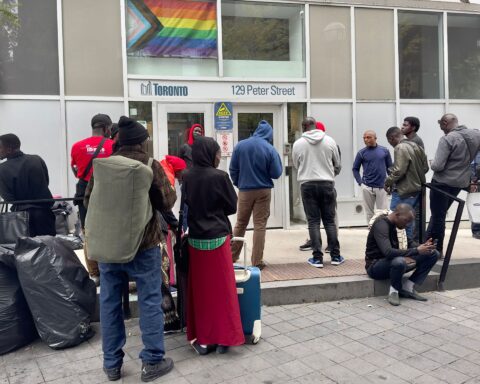Diana Nayel immigrated to Toronto from Sweden with her sister in June 2012, leaving behind all things familiar. She started her first day of Grade 5 at Toronto’s Westway Junior School in the city’s west end feeling a bit lost. No one spoke Swedish in her class. She was unsure of her English skills. How long would it take to fit in, she wondered.
Muntasir Mohammed arrived from Dacca, Bangladesh in 2011. Although his English fluency helped him adapt faster to his Grade 5 classmates in Etobicoke, Ont., he was uncomfortable carrying homemade curries to school. His lunchbox always contained cookies or chicken nuggets, compromising nutrition for the need to fit in.
Salma Syed (whose has been name changed for privacy) wears her hijab with pride, like many of her Grade 7 classmates at Toronto’s Islington Junior Middle School, but is quick to take it off when she’s out with her friends in an effort to blend in with society at large. Her parents migrated from Dacca, Bangladesh in 1999.
For 12-year-old Aneeka Ray (full disclosure: she is my daughter), she arrived in Toronto in 2013 from Bangkok, Thailand and being a newcomer made her the easy target of a cyber bully. She was not the first one, either. According to her friend, other shy newcomers had faced similar experiences at school.
Finding ways to assimilate
Each year, over 50,000 children arrive in Canada, and like Nayel, Mohammed, Syed and Ray, they are unsure of how they will fit in.
Some are war refugees; some are typhoon victims. Some have parents with low literacy levels. Others are financially challenged. And the education system itself is unfamiliar.
Their parents or guardians often get sucked into their new world of struggle, leaving children to fend for themselves. Kids are whisked off to a neighbourhood school, expected to take to it like fish to water, even though it is difficult to find their bearings.
“Once a new child sees a peer group of the same ethnicity, they are quicker to form a bond.”
Canadian schools offer free education and equal opportunities. But is the system doing enough to ensure newcomer children a chance at educational success?
“In many schools a sizeable number of students are naturalized Canadians from various ethnic backgrounds,” explains Manoshi Chatterjee, who teaches in an elementary school in York region. “Once a new child sees a peer group of the same ethnicity, they are quicker to form a bond. Group activities help them participate and assimilate.”
This was true for Nayel. Even though she isn’t of Somali descent herself, when she started a new school her second year of being in Canada where there were many Somali Canadians, the setting felt more familiar.
“My school in Sweden was in a Somali neighbourhood,” explains Nayel. “My new friends made me feel much more at home (in Canada).”
For Nayel, English as Second Language (ESL) classes helped polish her linguistic skills, which she initially felt insecure about.
“ESL programs play a pivotal role for immigrant students who struggle with reading, writing or communicating in the language,” explains Chatterjee whose school (she didn’t want to disclose the name for privacy), like most others, champions the program.
Supporting newcomer students
Jane Chandler, an elementary school teacher with the Peel Board District Board in Mississauga says that schools play a vital role in helping students adjust. She highlights the Peel board’s parenting centres, where adults are encouraged to participate with their children, as a prime example of this.
“This acts as a wonderful platform,” Chandler says. “The family gets to know the culture of Canadian schools. Parents get opportunities to share stories about their own culture and learn from others. We encourage students to speak their own language at home. This may slow down the English learning process, but in the long run, it (multi-lingualism) has several benefits.”
“[Students] are taught to value the richness of their own culture and at the same time develop respect for others.”
Keya Ghosh, an elementary school supply teacher for the Toronto District School Board (TDSB) hones in on diversity.
“Our schools play a critical role in making students appreciate their differences,” Ghosh says. “[Students] are taught to value the richness of their own culture and at the same time develop respect for others.”
Ghosh points to special events celebrated across TDSB schools like African Heritage Month and ‘multicultural day’ as examples of this.
Outside of the Greater Toronto Area, initiatives like Newcomers’ Orientation Week, which was held by one Windsor, Ont. high school, help to put anxious newcomers at ease.
Canadian schools amongst top in the world
The efforts Canadian schools make to support newcomer and culturally diverse students is perhaps a reflection of an education system in fairly good shape.
“A quality and free education helps every new immigrant family get equal opportunity in one of the best school systems in the world.”
According to an international education survey reported by CBC, Canadian schools are among the top globally, right after China (Shanghai province), Korea, Finland, Hong Kong and Singapore.
The report states, “Students in Canada tend to perform well regardless of their socio-economic background or the school they attend.”
On a regional level, Ontario, Alberta and British Columbia rank highest in reading skills.
“A quality and free education helps every new immigrant family get equal opportunity in one of the best school systems in the world,” says Chatterjee. “It is one of the major factors that have helped newcomers integrate into Canadian society.”
Collective Convenor & Communications Planner - Joyeeta Ray is a multimedia journalist, internationally awarded digital content specialist, and children’s books author, based in Toronto. Born in India, she brings over two decades of advertising and journalism experience across seven countries to Canada. Joyeeta started her journalistic career in Jakarta, led an editorial team in Bangkok, and is a student of Multimedia Journalism from The University of Toronto. She is an enthusiastic NCM-CAJ member, actively involved in amplifying new Canadian voices as NCM’s Convenor, Communications Planner, Mentor, and Reporter.





